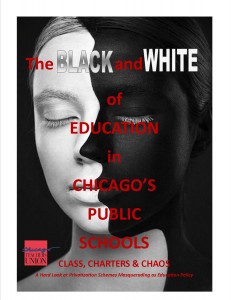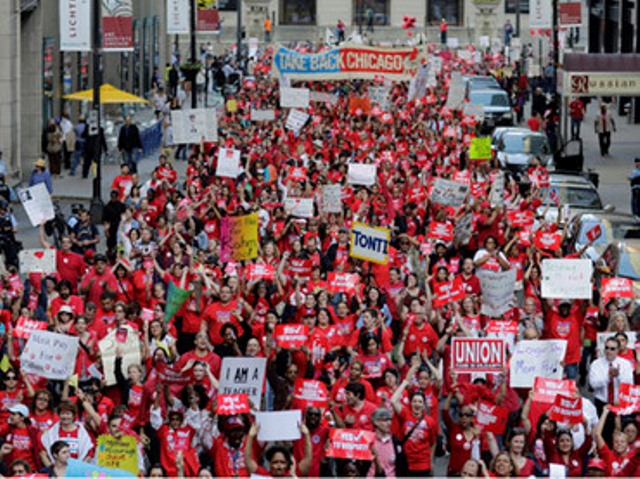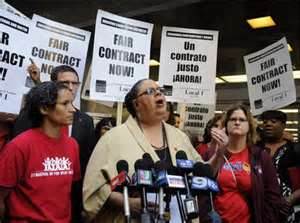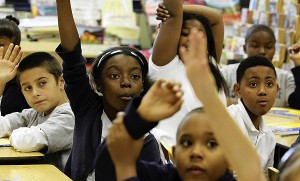by CTU Communications | 11/30/2012
http://www.ctunet.com/blog/the-black-and-white-of-education-in-chicagos-public-schools
Forwarded by Detroit Public Schools teacher Steve Conn
CHICAGO—The Chicago Teachers Union (CTU) released today a report on the “underutilization crisis” in the Chicago Public Schools system, a crisis that has been manufactured largely to justify the replacement of neighborhood schools by privatized charters. The study, titled The Black and White of Education in Chicago’s Public Schools, analyzes the mechanisms and effects of CPS schemes that masquerade as educational policy.
 While the policy of neighborhood school closings and charter openings has not moved education in Chicago forward in any significant way, the benefits to charter school operators, private testing companies, real estate interests, and wealthy bankers are growing. Far from being a system of reform that improves education, the policy of closing schools in one area of the city and opening schools in another has been the failed status quo in Chicago for nearly 20 years, and key outcomes are:
While the policy of neighborhood school closings and charter openings has not moved education in Chicago forward in any significant way, the benefits to charter school operators, private testing companies, real estate interests, and wealthy bankers are growing. Far from being a system of reform that improves education, the policy of closing schools in one area of the city and opening schools in another has been the failed status quo in Chicago for nearly 20 years, and key outcomes are:
- Increased racial segregation in schools
- Depletion of stable schools in Black neighborhoods
- Disrespect and poor treatment of teachers
- Expansion of unnecessary testing
- Decreased opportunities for deep, conceptual learning
- Increased punitive student discipline
- Increased student mobility
- Minimal educational outcomes
“When it comes to matters of race and education in Chicago, the attack on public schools is endemic,” said CTU President Karen GJ Lewis. “Chicago is the most segregated city in the country, and our students of color are routinely deemed as second-class by a system that does nothing but present one failed policy after the next.”
The Black and White of Education in Chicago’s Public Schools has three major sections describing CPS’ failed public education policy. Part One, “Playing Musical Chairs with CPS Schools—Facilities Decisions and School Actions in the Age of Mayoral Control,” assesses the processes and outcomes of school actions, facilities decisions and charter proliferation; Part Two, “Students First or Students Last? Setting the Record Straight on the Portfolio District,” investigates the realities of student outcomes, district and charter budgets, charter waiting lists and the Gates Foundation charter school compact; and Part Three, “Innovation in Name Only: Charter Education,” examines the true nature of charter operators’ alleged innovations—excessive test-focused curricula, harsh student discipline, exploited teachers and reduced teacher diversity and parental input regarding their children’s education.
The study examines the history of school attacks in Chicago, and whether educational apartheid is being implemented under the guise of educational improvement. More than 42,000 students have been directly impacted since CPS school actions began in 2001 and 88 percent of those affected have been African American. Schools where the overwhelming majority of students are children of color have been the primary target—representing more than 80 percent of all affected schools—and Black communities have been hit the hardest, as three out of every four affected schools were economically disadvantaged and extremely segregated African American schools.
In Part Three of The Black and White of Education in Chicago’s Public Schools, truly innovative policies that have been implemented in neighborhood CPS schools are highlighted, such as the Children’s Literacy Initiative, Lesson Study and Responsive Classroom. These successes, along with this and other reports of the kind, disprove the notion that privatization is the panacea for Chicago’s public education. While charter operators and their philanthropist backers claim that public education is the problem, there are no consistent results that substantiate the belief that charters create better educational outcomes than neighborhood schools.
The study also unveils the hidden costs of charter expansions by examining the United Neighborhood Organizations (UNO) aggressive charter school expansion. UNO’s ever-growing debt and accompanying high interest is paid out of taxpayers’ pockets. In 2000, UNO Charter School Network (UCSN) had outstanding debt of $1.5 million, but by 2011 its debt had ballooned to more than $71 million. In 2009, the state of Illinois gave UNO close to $100 million in taxpayer funds, however, even with state money, UNO’s 2011 bond issue was still rated BBB (lowest investment grade; just above junk, bond status) and given an effective interest rate of over 7 percent.
“What charter expansion says is that we’ve given up—we’ve given up on public schools, given up on our teachers and given up on the children and families that need us the most,” said CTU researcher Dr. Carol Caref.
When children become commodities and education becomes just another business, we lose the idea that all children, regardless of race or socioeconomic status, are entitled to a high-quality public education that provides each child with the conditions for success. The privatization and corporate reform experiment has failed. It is time to implement proven measures and reinvest in our neighborhood schools.







